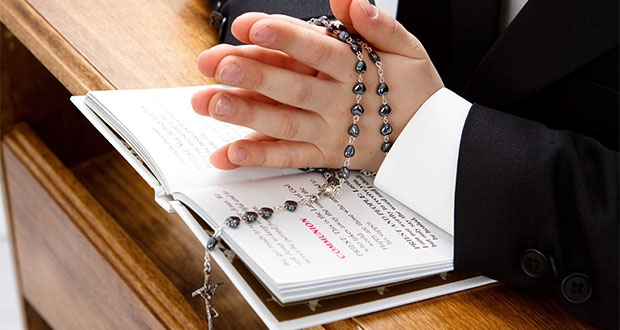The Catholic family home is often hazardous to sacramentals. Knowing that these sacramentals are symbols of holy people and things, we try to be respectful. We do. But there seems to be always such a clutter everywhere! These things accumulate, particularly with children. After baptisms, after First Communions, after feast days, there are always more sacramentals that come into the home to plague our conscience with worries. Worries that maybe, for example, we shouldn’t own a thousand rosaries.
We gather our beads in colorful nests to reverently detangle, later on, when we have a moment free. We have a pile, a drawer, a basket, somewhere, with tattered holy cards, tarnished medals, little, plastic, broken-winged angels and endless snarls of unraveling scapulars which are all waiting to be properly addressed. We stack higher and higher the Baltimore Catechisms and the biographies of saints who smilingly remind us from their serious bindings that we ought to be perfect if we want eternal life. I have swept up many splinters of Holy Week palms, picking them out of the dust bunnies, and worried about the state of my soul.
There is one particular crucifix which has been floating around in our house for as long as I can remember. I am forever finding it in random places. It is five inches tall or so; a wooden cross with a colorless, plastic Jesus, except that his hair is brown. Over the years I have found this crucifix everywhere—in the toy box, for instance. I take it out and put it on my desk until I can decide what to do with it. Then, it’s somehow under a bed. I fish it out and put it on my desk. Later, it’s behind the couch. I turn off the vacuum, pick it up and put it on my desk. I feel like it follows me around the house, this little cross with little Jesus on it.
Many sacramentals are beautiful works of art, lovingly created to lift the soul, but this is not one of those. This crucifix is so poorly designed and made that surely no devoted heart and hands could have fashioned it. Scripture tells us to give our best to God, but certainly this is not anyone’s best work. It seems more like a cruel joke played on those so devoted that they will purchase anything. Rather than moving me to devotion, it moves me to frustration.
Then, one day, I find that plastic Jesus is missing part of his arm. The middle of his arm is completely gone! How did this happen? I have no idea. His hand is still nailed to the cross but his little plastic forearm is gone.
“Poor Jesus!” I think.
Strangely, I feel something. Out of guilt and pity, I give in and hang it above my writing desk.
As the days pass, I start noticing him there. I look at the cross and shake my head at the poor craftsmanship. And then it occurs to me that maybe this is, in fact, the best crucifix I have ever laid eyes upon. For when I see it, I immediately think that Jesus is in pain, that he is miserable up there on that cross and I want to take him off. I want to fix him. I want to find the rest of his arm. Somehow this little cross has made me look past the plastic man to the Savior it represents.
Somehow I realize that I can fix his arm, with love and sacrifice. Somehow I feel that putting this plastic representation of Jesus above my desk is an act in itself which is pleasing to God. Perhaps, when we look at a great work of Christian art, the sheer beauty of the art distracts us from the message it is meant to convey. But this little crucifix, having no intrinsic beauty, reminds me of the verse from Isaiah about the suffering servant, “He had no beauty or majesty to attract us to him, nothing in his appearance that we should desire him.” The lack of beauty helps me remember to think of the One who is waiting for us to be there.
I wonder if it’s hard for Him to watch us make such plastic versions of Himself. But then, we are foolish plastic versions of ourselves too, ever striving in this world of imperfection to be what he calls us to be.
by Alanna Smithee, a pseudonym for a homeschooling mother

 Seton Magazine Catholic Homeschool Articles, Advice & Resources
Seton Magazine Catholic Homeschool Articles, Advice & Resources
